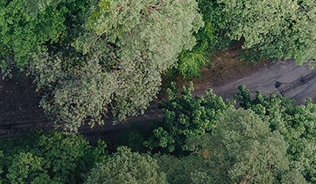The fourth day of COP27 is focused on science and the central role that science and scientists play in climate mitigation, adaptation and resilience. Scientists have been at the forefront of understanding the causes and impacts of climate change, and scientific knowledge and practice will be foundational to effective climate action; science and evidence-based solutions must be at the fore of climate action.
Today, to mark the Science-themed day of COP27, we are exploring and championing the work of environmental scientists from different specialisms and how it relates to climate change and net zero ambitions. Hear from a few of our members below:
Eleni Antoniadies, Project Environmental Lead at EA Environmental Ltd and Vice Chair of the IES
 As a Project Environmental Lead working in the aviation and infrastructure sector, my projects face significant challenges on the pathway to net zero. I like to focus on the greatest carbon source for all my projects and make significant reductions.
As a Project Environmental Lead working in the aviation and infrastructure sector, my projects face significant challenges on the pathway to net zero. I like to focus on the greatest carbon source for all my projects and make significant reductions.
Recently, I have worked on reconstruction and rehabilitation of three airfield projects. The production of concrete and asphalt represents one of the construction industry's highest carbon footprints. On a recently completed project, we addressed this challenge through the recycling of site-won concrete. Concrete was broken out, crushed and screened on site. The processed concrete was then used for the production of Cement Bound Granular Material (CBGM) using a concrete batching plant, in place of virgin aggregates, providing a huge carbon saving. Recycling concrete on site also means no haulage of concrete waste off site, no haulage of virgin aggregates to site, and onsite production avoids the transport of CBGM. Overall, this provided a carbon saving of 90% in comparison to use of virgin aggregates, contributed to the circular economy and reduced construction traffic. It is a simple approach, easily replicated with careful site planning, offering huge carbon reductions.
Carbon reduction for an aviation-based organisation in Antarctica provided a technically complicated challenge. When the highest carbon source arises from aviation, logistics and flight planning in Antarctica and efficient aircraft can only reduce carbon emissions to a certain level. I started exploring Sustainable Aviation Fuel (SAF), produced from waste oils and greases (as opposed to a bio-crops). Pure SAF produced from waste provides a carbon saving of 80% in comparison to conventional jet fuel. Current permitted SAF blends of 30-50% ( SAF: Jet A1) provide an overall carbon saving of 24-40%. SAF produced from waste also contributes to the circular economy and has lower emissions of soot and SOx, which is even more important when operating in Antarctic air quality. This year, we will be carrying out Antarctica’s first SAF flight, and in future seasons we propose to meet science-based targets through use of SAF blends for all Antarctic aviation activities.
Net Zero should also be about the environment as a whole: air quality, habitat restoration, land remediation. All environmental professionals should seek immediate and practical solutions.
Kathryn Collins, Principal Consultant, Howell Marine Consulting and member of the IES Policy Committee
 Reaching the UK’s net zero ambition relies heavily on our ability to construct offshore wind at an unprecedented scale. In order to reach the UK government's target of 40GW of offshore wind capacity by 2030, we need to find a way to manage environmental impacts strategically. A lot of the work our team is working on for various UK clients focuses on the challenges of moving towards the use of strategic compensation within Habitats Regulations Assessment (HRA) and the use of strategic monitoring data in both HRA and Environment Impact Assessment. These strategic approaches are challenging as they move away from the project-level compensatory measures which are currently attached to offshore wind consents. However, the current approach is not fit for purpose when considering the scale of the challenge of finding space for offshore wind, nature and other marine uses to coexist. Without strategic compensation, we risk an unsustainable approach to providing mitigation to project-level impacts, such as providing alternative breeding and nesting sites for protected bird species. Strategic monitoring is also needed to allow for a more holistic approach to the collection of monitoring data for project design. Both strategic compensation and strategic monitoring are needed in order to decarbonise our energy supply.
Reaching the UK’s net zero ambition relies heavily on our ability to construct offshore wind at an unprecedented scale. In order to reach the UK government's target of 40GW of offshore wind capacity by 2030, we need to find a way to manage environmental impacts strategically. A lot of the work our team is working on for various UK clients focuses on the challenges of moving towards the use of strategic compensation within Habitats Regulations Assessment (HRA) and the use of strategic monitoring data in both HRA and Environment Impact Assessment. These strategic approaches are challenging as they move away from the project-level compensatory measures which are currently attached to offshore wind consents. However, the current approach is not fit for purpose when considering the scale of the challenge of finding space for offshore wind, nature and other marine uses to coexist. Without strategic compensation, we risk an unsustainable approach to providing mitigation to project-level impacts, such as providing alternative breeding and nesting sites for protected bird species. Strategic monitoring is also needed to allow for a more holistic approach to the collection of monitoring data for project design. Both strategic compensation and strategic monitoring are needed in order to decarbonise our energy supply.
Climate change accelerates the need for innovative solutions, and for all of us working in this sector, the challenge is one we cannot afford to fail at.
Chris Rush, Associate Director Hoare Lea and Chair of the IAQM's Climate Change Working Group
 Prominence of the quality of the air we breathe, and that this can impact our health and wellbeing, has seen a significant surge. The pandemic and recent heatwaves are both examples where our everyday lives have had to adapt, meaning greater time spent inside buildings. The importance of how we ventilate these spaces to help manage diseases, temperatures from extreme climate change related events, and the quality of the air, can have an energy and materials cost – both of which have associated emissions that contribute to climate change.
Prominence of the quality of the air we breathe, and that this can impact our health and wellbeing, has seen a significant surge. The pandemic and recent heatwaves are both examples where our everyday lives have had to adapt, meaning greater time spent inside buildings. The importance of how we ventilate these spaces to help manage diseases, temperatures from extreme climate change related events, and the quality of the air, can have an energy and materials cost – both of which have associated emissions that contribute to climate change.
There can exist a conflict between considering human health outcomes and more planet-related elements such as reducing climate change related emissions. Increased ventilation rates along with air treatment can improve the air within a space for an individual’s health – but comes with an energy cost. Both human health and climate change cannot be considered in isolation, with an optimised solution being delivered and in certain cases a balance achieved.
Designing effective ventilation, managing its implementation and ongoing performance, are elements that are critical to ensuring human-centric aspirations are positively balanced with planet-conscious aspects.
Support science-led policy and practice
Take a read of our Manifesto for Transformative Change for more information on the role of science and innovation in climate action.
If you are a member of the IES, join our Climate Action Community, a multi-disciplinary community of environmental scientists leading our work in this area.
If you are not a member and want to support our work to ensure effective and science-led environmental policy, you can join as a Climate Affiliate, or if you’re a professional in the environmental sector working with science, consider becoming a member of the IES.





